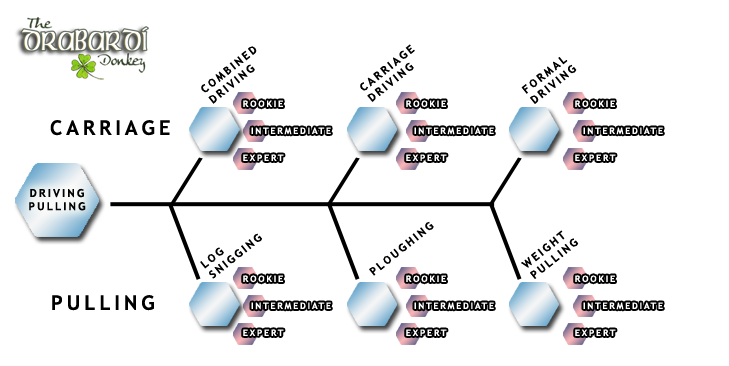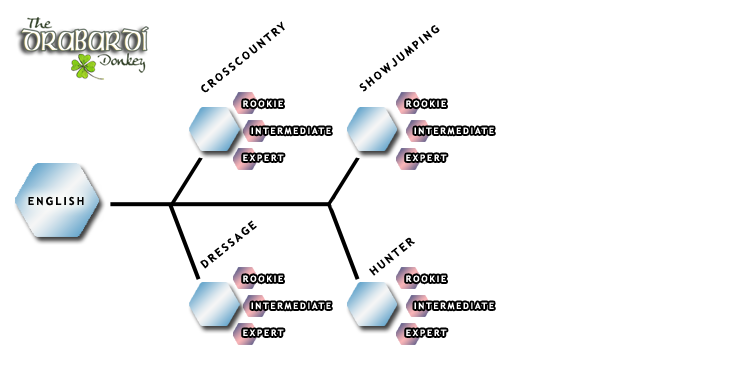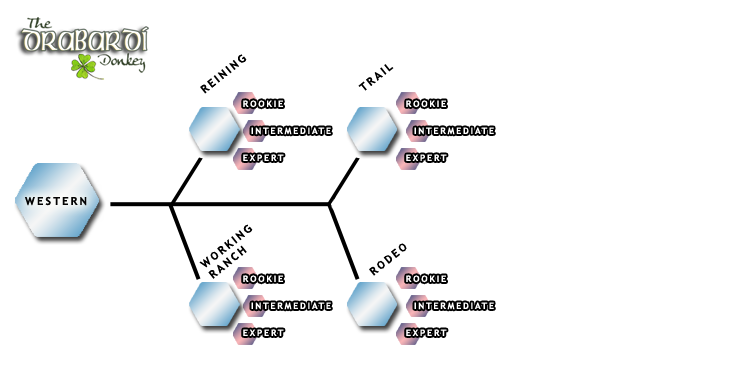How does it work?
These careers are made for the HARPG donkeys in mind. If you are looking for something similar for the wild donkey, look at the herdroles. There are THREE different levels,
- - Rookie
- - Intermediate
- - Expert
Criterias & Rewards
# Rookie (Ro)
New beginings - Learning something new ART: Minimum half body art in color, simple BG in color LITERATURE: At least 1000 WC. Promt reward for this level/per task
- 25 D$
- 0.5 in Experience
- + any reward stated in each "taskbox"
# Intermediate (Int)
Character must have finished the Rookie tier. ART: Fullbody art, simple BG in color LITERATURE: At least 1200 WC. Promt reward for this level/per task
- 50 D$
- 0.5 in Experience
- + any reward stated in each "taskbox"
# Expert (Exp)
Character must have finished the Intermediate tier. ART: Fullbody + complex BG in color LITERATURE: At least 1500 WC. Promt reward for this level/per task
- 75 D$
- 0.5 in Experience
- + any reward stated in each "taskbox"
UPTo learn about the actual tasks to do and where to submit please go to the correct journal in the DA group! REMEMBER - Each donkey can only do each task ONCE.
Driving/Pulling
With the term driving means hitching a donkey to a wagon, carriage, cart, sleigh, or another vehicle drawn by the donkey by means of a harness. The term 'in harness' is often used to describe a donkey being driven. The different types of what a 'donkey in harness' can do have been devided into two groups, a little depending on what your own interest might be.
Carriage
This is more about pulling "pretty" wagons with bling thing. When all tasks is done your donkey will get a final bonus to use in competitiondriving within the group. Examples on competitions a carriage donkey might enter are
- Combined driving
- Carriage driving
- Formal driving

Pulling
For working purposes, the donkey can pull a plow or other farm equipment, in other words this is more "farmbased" and practical. When all tasks is done your donkey will get a final bonus to use in pulling competitions within the group. Today the group will offer the following types to train in.
Log snigging - Using a Drabardi donkey to remove felled timber. This way of removing timber is making a comeback in ecologically-sensitive woodlands.
Ploughing
Weight pulling - Competition where donkeys (often Barri Drabardis) in harness, usually one or two, pull a stone-boat or weighted sled and the winner is the team or animal that can pull the most weight for a short distance.
English
Crosscountry
It is a must to wear a protective vest and a helmet. Riders can wear shirts in colours they chose themselves, the breeches usually match the shirt/vest color. Riding coats are usually not worn. Many riders also wear a stop-watch (to track their time). Tack Basicly like in showjumping, ie a jumping saddle, usually together with a square or fitted white pad, cross country boots, breastplate and most forms of bridling and bitting are allowed. Some can also greese their donkeys legs in case they would get caught in an obsticle. The course/jumps A crosscounty course is like a show jumpingcourse but have fixed and solid obstacles through fields and wooded areas. Obstacles out on the course are usually built to look "natural" and can include water, trees, logs, ditches, and banks. Something to think about! These jumps aren't as tall as the obstacles are for horses. Think more of pony sized ones.
Dressage
A rider that is to compete in dressage wear a white shirt, a tie of any kind, white riding breeches, gloves (any colour; white, fawn, or cream), and riding boots (of any colour) and a top hat. Tack The tack is usually black in color, the saddlepad is usually a white square pad, giving it a formal look. Unless you compete in the upper levels, where a double bridle is permitted, donkeys are usually ridden in simple snaffle bits.

Hunter
Tack should be somewhat workmanlike, with bridles that having a flat noseband and plain browband. Handlers should wear tweed jackets, shirt and tie, buff or canary breeches, black leather boots with garter straps. Tack English saddle (often with a "close contact" design) and bridle, usually "fitted" fleece pads that are the same shape as the saddle. Common with boots and/or wraps (to protect the donkey's legs) The course/jumps The course for the hunter class can for example include an open water or "liverpool" obstacle, have a varied terrain, a bank with a vertical fences on the top or bottom, or with a ditch under an obstacle. Something to think about! These jumps aren't as tall as the jumps are for horses. Think more of pony show jumping.
Showjumping
The attire for showjumping is less formal than what used in hunter riding. A helmet is always required, so are black tall boots. Spurs are common but are optional to use. Breeches are traditional in color (white, tan, or beige). Over a light-colored (usually white) shirt and either a choker or stock tie a dark-colored coat usually is worn. Tack English saddle (often with a "close contact" design) and bridle, usually white and square saddle pad. Common with boots and/or wraps (to protect the donkey's legs) The course/jumps Jumps that can be on a course - vertical, oxer (different kinds), triple bar, cross rail, wall, hogsback, combination, open water, liverpool. Show jumping fences often are colorful, sometimes very elaborate and artistic in design.Something to think about! These jumps aren't as tall as the jumps are for horses. Think more of pony show jumping.
UPMounted Archery
Requirement:
Done the Expert task levels of at least two of the English or Western sports.
When you pass the last assignment in the Mounted Archery task you will be able to do something extra on your adventures - you and your donkey will be able to go out hunting. THIS TASK CAN BE DONE FOR BOTH ENGLISH AND WESTERN!
UPRacing
Just like for horses, the different types of racing for the Drabardi donkey have been devided into four different groups that all differ somewhat in terms of how it is run and what you do with your donkey. When all tasks is done your donkey will get a final bonus (differs depending what group you finish the tasks in) to use in the different racingcompetitions within the group.

Endurance
In all gaits the donkey and its rider go across the country, in all kinds of terrain and over extreme distances.
Flat
A racecompetition where the donkeys run between two points around oval track, on dirt or turf
Harness
The donkeys trot while pulling a driver in a sulky around two points around a oval track, always on dirt.
Steeplechase
Similar to the flatracing but here the donkeys also need to jump over obstacles.
UPWestern
Donkeys that can be characterized by having good agility, quickness, and powerful hindquarters are perfect for western games. They are also usually noted for intelligence and having a"cow sense," having an instinctive understanding of how to respond to the movement of cattle so as to move livestock in a desired manner with minimal or no guidance from their rider. Such donkeys are used both as working animals on livestock stations on the Island as well in the HARPG, but are also seen in competition where donkeys (and horses) are evaluated on their ability to work cattle. Tack unless noted should be looked up and be appropiate.

Reining
Reining is often described as a Western form of dressage riding. The riders guide the donkey through a precise pattern of circles, spins, and stops. All work is done at the lope, or the gallop. Tack Western saddle. Bridles are western-styled, without a noseband or cavesson. Usually splint boots are worn on the front legs and skid boots on their hind fetlocks. Bell boots that are wrapped around the pastern are also usually seen, sometimes only on the front feet, other times on all four feet. Polo wraps are also another form of protection that is used. Spurs are allowed.
Trail
The rider and donkey work a single live cow in an arena in a special pattern.
Rodeo
Rodeo competitions most commonly consist of calf roping, team roping, steer wrestling, saddle bronc and bareback bronc riding, bull riding, and barrel racing. You pick any of these.
Working ranch
Show your donkey and rider doing 'real' ranch work - not in a competition
UP